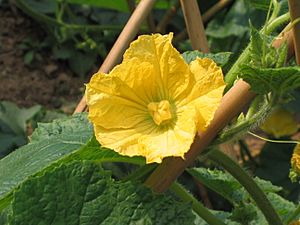Chi qua facts for kids
Quick facts for kids Benincasa hispida var. chieh-qua |
|
|---|---|
 |
|
| Flower of B. hispida v. chieh-qua | |
| Scientific classification |
|
| Kingdom: | Plantae |
| Clade: | Tracheophytes |
| Clade: | Angiosperms |
| Clade: | Eudicots |
| Clade: | Rosids |
| Order: | Cucurbitales |
| Family: | Cucurbitaceae |
| Genus: | Benincasa |
| Species: | |
| Varietas: |
B. h. var. chieh-qua
|
| Trinomial name | |
| Benincasa hispida var. chieh-qua F.C.How, 1954
|
|
Chi qua is a special kind of fruit. It comes from a plant called Benincasa hispida var. chieh-qua. You can think of it as a cousin to the wax gourd. This fruit is a very common and important part of Chinese meals.
What's in a Name?
This fruit has a few different names. In Chinese, it's often called chi qua (simplified Chinese: 节瓜; traditional Chinese: 節瓜; Mandarin Pinyin: jiéguā; Jyutping: zit3 gwaa1). It can also be known as moa qua or moa gua (Chinese: 毛瓜; Mandarin Pinyin: máoguā; Jyutping: mou4 gwaa1; literally "hairy gourd"). This second name means "hairy gourd" because of its fuzzy skin.
In English, people call it many things. Some common names are hairy melon, fuzzy gourd, or fuzzy squash. It's also sometimes called Chinese preserving melon or small winter melon.
Where Does Chi Qua Grow?
Chi qua fruits grow on long vines. They need warm weather to grow well. The best temperatures for them are between 25°C and 35°C (that's 77°F to 95°F). They don't like cold weather or frost at all.
In China, chi qua is grown a lot in the areas of Guangdong and Guangxi. These places have the warm climate that the plants need.
How Do We Use Chi Qua?
Chi quas are covered in tiny, fine hairs. Because of these hairs, you need to be careful when preparing them. This helps avoid any skin irritation.
Young chi quas can be eaten raw, but most of the time, people cook them. They are prepared and eaten in a similar way to summer squash or zucchini. In China, people usually eat them during the summer months.
This gourd is also used in many other types of cooking around the world. You can find it in dishes from the Andes mountains, the Caribbean islands, East Africa, India, Mexico, South America, and Southeast Asia. It's a very versatile vegetable!

